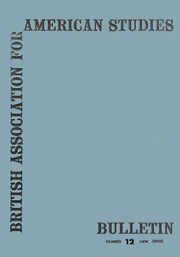No CrossRef data available.
Article contents
An Emigrant's Letter from Iowa, 1871
Published online by Cambridge University Press: 17 February 2011
Extract
John Flounders Dixon was born in 1844 at Crathorne, near Yarm, in the Cleveland district south of the Tees in the North Riding of Yorkshire and was thus 27 years of age in 1871 when he made the journey to America described by him in the following letter. His companions were his younger brother, Charles Albert, aged 22, and Frank Standing to whose uncle's farm in Iowa they travelled.
- Type
- Research Article
- Information
- Copyright
- Copyright © British Association for American Studies 1966




